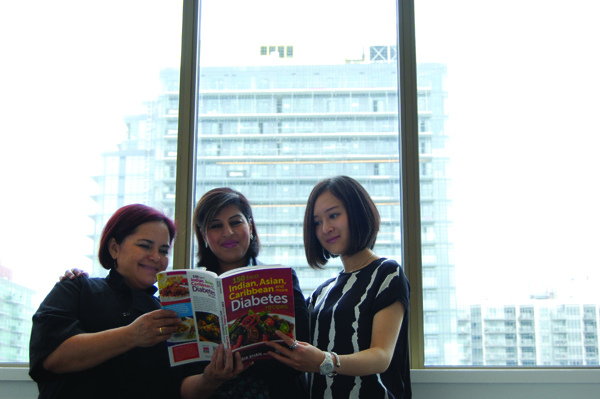In order to make our learning interesting, professors’ assignments are not only constructive, sometimes they are also creative

Professor Sobia Khan, Registered Dietitian, spent five years and with many help by her friend chef Mali Fernaindez (left) and her former student Jiaqi Li to finish her diabetes care cookbook.
Photo: Dora Liu/The Dialog
Sobia Khan has been a professor of food and nutrition at George Brown College’s (GBC) centre for hospitality and culinary arts for eight years, and is also a registered dietitian.
With her father suffering from type two diabetes, Khan studied diabetes as her major and in 2007 she thought of applying for a fund to help her dig into this topic, which would provide a meaningful learning opportunity for her and her students.
“The funding required my research project to involve students and community members. Originating from Indian culture, as I have many students from different cultures, I narrowed down my project’s focus to developing diabetes-friendly recipes from traditional multicultural foods,” said Khan, accompanied by her friend Chef Mali Fernandez as well as her former student Jiaqi Li.
Starting in 2008, Khan established her team of chef friends, hired several of her students as assistants, set up related assignments for her nutrition culture class, and of course, got the back-up from GBC.
She and her team then set out to collect recipes from community centres, friends, and friends of friends.
“I needed all the recipes to come from real people, not the internet, and not from restaurants,” said Khan. This helped her to study multicultural cuisine.
She and her team kept visiting different communities, doing demos, and testing every single recipe again and again. This helped to adjust their beloved traditional recipes into healthier ones, which was more important than creating a new healthy recipe for them, Khan explained, on why she insisted to work on their old recipes.
Her students were to choose their own culture’s recipes, analyze them, test them, and adjust them into a diabetes-friendly recipe.
“I did learn a lot from this project,” said Li who also worked as one of the project assistants. “Diabetes is not only about sugar, fat and sodium are crucial.”
Li has loved cooking for a long time, and her father is also suffering from diabetes. She took charge of most of the Chinese cuisines for this project.
“I wanted to make my father’s favourite dishes healthier,” said Li.
Following Khan’s instructions to reduce oil, sugar and salt in the recipes she found, Li said, “the taste didn’t change too much. Actually the traditional home-made recipes are quite healthy, Its just the commercially-used recipes that have problems.” Khan nodded as Li spoke.
Chef Fernandez agreed as well. She took care of the Mexican and Spanish cuisine in the project as she is Spanish, and she owned a Mexican restaurant in Toronto.
“I found it quite difficult to follow Sobia’s rule in the beginning. You know, fat is the key ingredient for the taste. But we have to cut fat,” said Fernandez looking at Khan with a smile. “It’s just too much unnecessary oil in one dish. We just took away the unnecessary oil and it didn’t affect the good taste,” said Khan.
After four years of practice they all got used to the diabetic diet format and the project was complete. Khan then thought, why not put this great work into a record for the public?
Khan selected the best 150 recipes, re-tested and re-analyzed them again.
The end result was the cookbook, “150 Best Indian, Asian, Caribbean (and More) Diabetes Recipes.”
Now, it has become the best gift for those who had worked very hard on this project, and for those who want to eat healthier.


